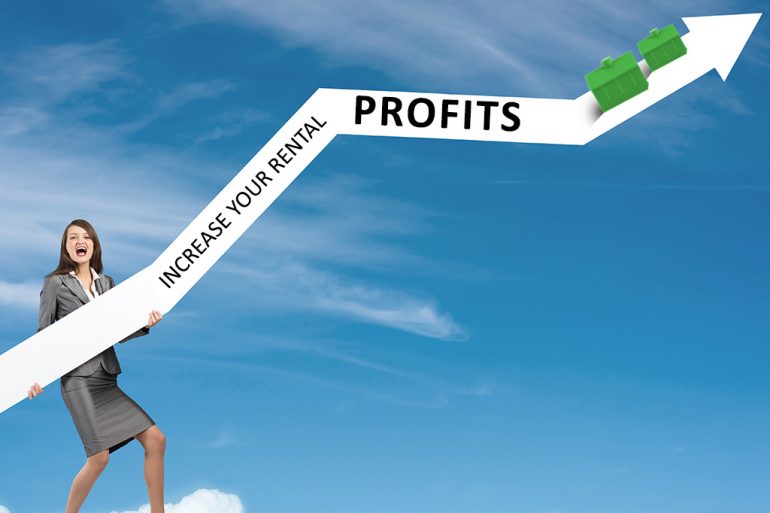See How to Increase Your Rental Profits
All real estate investors know the feeling. It’s the end of the fiscal year and time to review your books… and profits from your rentals were less than awe-inspiring this year. How can you increase those rental profits so you can justify your investments and not pull your hair out this time next year? How do you get to a point where the profits from your rentals allow you to continue investing even more and live a life of financial freedom?
A few key areas to focus on for increasing rental profits are property management, curb appeal, advertising, pricing and fees, vacancy management, and maintenance.
Find the Right Property Management Firm
Property management — when utilized correctly — can be one of the most powerful tools in a real estate investor’s tool belt. On the other hand, when improperly utilized, it can be one of the most detrimental influences on an investor’s monthly rental income.
If you’re self-managing your rental properties and cannot seem to get to profit levels you’re happy with, it’s time to begin interviewing property management firms. These interviews will help you decide which firm is the best fit for you and your properties. Be sure to ask each manager what their advice would be and how they would increase profitability. It’s also important to ask them how they would manage common issues associated with your tenants, such as noise complaints, lease violations, and pet problems.
An experienced property manager will come on board your team with knowledge of your properties and, over the course of several months, quickly turn them around if they are not profitable. Additionally, a good property manager can increase the profitability of said properties if they are already turning a profit. Good property managers are well-trained and know how to decrease expenses without decreasing quality of service. They will pay for themselves in no time.
If you’re in business with a property management company that is running your properties into the ground (and driving you into the red), it’s time to find a new management company. If this is not doable, you may need to carve out time in your own schedule to self-manage your rental properties.
A pro to self-management is that you won’t pay monthly management fees, which often come close to 10% of monthly rent on top of incidental fees for service calls, leasing, and any other expenses that would otherwise occur due to poor management (i.e., deferred maintenance).
Boost Your Property’s Curb Appeal
When looking to get your property rented out for the highest dollar possible, it is crucial to put your best foot forward. First impressions are a key factor in a successful sale! The front of the property is the very first thing a potential buyer sees when they are driving by. They want to see what the house and neighborhood look like, and the appearance may result in the potential buyer making a phone call to schedule a tour or moving on down the road while your property sits vacant for another month.
An action that costs little and has a large impact is weeding the yard — getting rid of a yard full of weeds makes a huge difference to potential renters. Nobody wants to live in a house that looks like an overgrown menagerie of grasses, thistles, and shrubbery. Spending a weekend pulling weeds before listing your property for rent ensures that you are putting its best foot forward.
Additionally, touching up paint and wood stain on any exterior surfaces lets potential renters know that you take good care of the property. The front door is a great place to start! To renters, this attention to detail shows that they too will be taken care of.
Finally, if maintaining a yard or flower bed is out of the question, it may be time to explore xeriscaping. This type of landscaping is an alternative to the traditional grass yard that consumes large amounts of water. Xeriscaping consists of placing crushed granite, river rocks, and plants that do well in semi-arid to arid climates and require minimal water in areas that would otherwise lay host to grass. If your region and climate allow it, this is a one-time investment that can save you money on water and yard maintenance while also creating an exceptionally clean appearance.
Take Advantage of Modern Advertising
With 21st-century renters comes the need for 21st-century advertising. Gone are the days of advertising in the local paper or putting a plastic sign in the yard to attract a highly qualified renter in a matter of days.
Modern renters find properties online, and it’s time for you to take advantage of technology. With platforms such as Zillow offering the ability to inexpensively list properties for rent online and get them in front of thousands of people, it’s a necessity rather than a luxury to utilize these platforms in today’s modern real estate market. Be sure to have professional-quality photos for your property to post online. No matter how good you are with your iPhone, the quality of photos done by professionals makes a difference to consumers browsing properties to rent.
The cost per lead on social media and search engines is miniscule in comparison to traditional media advertising like television, newspaper, and radio. Landlords who take advantage of technology save thousands of dollars when looking for qualified renters.
When you have a pool of qualified renters wanting your property, you can screen them and be selective (without violating Fair Housing Laws and discriminating based on race, color, national origin, religion, sex, familial status, or disability). Having the option to select the best possible tenants who are least likely to break lease — or become holdover tenants — allows you to retain consistent and reliable rent revenue. The question of whether rent will be paid each month won’t be a concern any longer.
Update Pricing and Fees Yearly
Are you increasing rents each year, or do you find yourself renting out properties for the same rate you had them listed for ten years ago? It’s important to push for rent increases every single year. Make sure that tenants know their rent has not been increased with the intent of pricing them out.
As the landlord, your expenses typically increase annually. Consider mentioning the following costs to your tenants, which they don’t always think of:
- The annual increase in property taxes you pay
- The annual cost of preventative maintenance
- Any capital improvements and updates that you have done to the property that have increased its value
As far as fees go, do not overlook non-rent revenue that you can utilize to supplement your bottom line. If your tenants have pets, charge a pet fee or pet rent. It is not uncommon to charge a non-refundable fee of $275 for pets with either recurring monthly rent of $15-25 per pet or a refundable pet deposit of another $100-200. This is typically used to cover any minor damages caused by pets or given back if the property is left with no signs of pet damage.
If tenants do not want to sign a 12-month lease (or their lease expires and they do not immediately renew), they are in a month-to-month situation. You need to charge a premium for tenants who are leasing on a month-to-month basis as they add a layer of increased risk to your investment portfolio — you do not know if they will be renewing each month. On a property renting for $1,200 per month, it is not uncommon to include in their lease that should payment go month-to-month, the lease rate increases to $1,450 per month until they either provide notice that they intend to vacate the property or renew their lease with you for another term.
Handle Property Vacancies the Smart Way
How much are your tenants worth to you? This is an important question to ask when considering whether to lose a tenant over a small increase in monthly rent. If the average time it takes to get a unit rent ready and leased is 30 days in your market, you must think about the cost of your vacant unit for that month compared to the increase in value from raising the rent by the amount in question.
For example, you are renting a property out for $1,200 per month and want to raise it to $1,250. However, your tenants absolutely cannot afford to make that leap to $1,250. Is it worth it to only increase to $1,225 per month in order to keep those tenants in your property and make an additional $300 per year? The alternative is losing a minimum of $1,200 for the month (or several months) that the property is vacant while being made ready for the next tenant and leased out.
Keep Up on Maintenance Before It Becomes a Problem
Property maintenance is a balancing act that can take time to master. While it is an expense that many do not like to see, it’s vital to maintain your property over the years and perform preventative maintenance to keep larger bills from popping up down the road.
When taken care of immediately, water leaks and roof damage may cost a few hundred dollars, but a new roof and mold remediation on a condemned property cost a whole lot more.
Take care of your properties and they will take care of you in the long run. A great way to budget for this and prevent yourself from getting into a bad situation is to set aside replacement reserves each month for these maintenance items. Fifty dollars set aside each month for regular maintenance expenses will save you from heartbreak in the future.
Stop Stressing Over Your Lackluster Rental Profits and Start Implementing These Strategies
Nothing good comes easy, and increasing your rental profits is no different. While it takes time, effort, and money to implement the suggestions we provided, it will be worth it in the long run. Whether you get started by educating yourself on advertising or pulling gnarly weeds from your properties’ lawns, any step in the right direction will get you closer to your goals.








